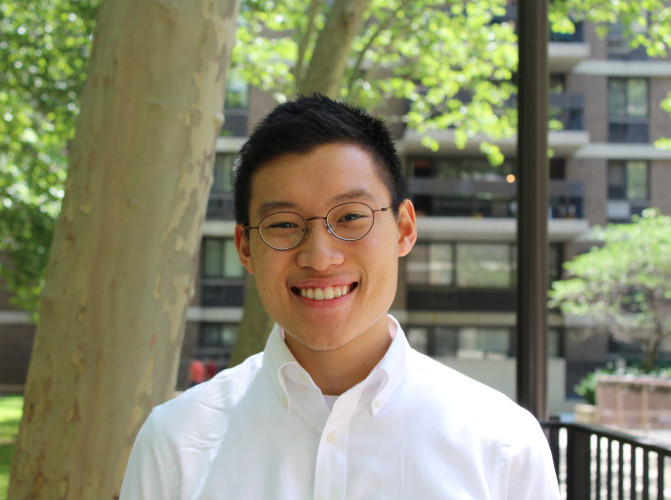Summer 2016 Visual Design Intern: Win Shanokprasith

Freshkills Park is excited to introduce and welcome Win Shanokprasith, the new Visual Design Intern, to the team. Win is a recent graduate from the Maryland Institute College of Art, and he is an artist, designer, and arts educator.
What is your name and title?
My full name is Kawin Shanokprasith (pronounced: GA-WIN / SHA-NOK-PRA-SIT). It’s Thai, and Shanokprasith means “the Gift from Father.” It is also customary in Thailand for people to have nicknames—mine is “Win.” I am a Visual Design Intern at Freshkills Park!
What are you working on?
Freshkills Park is a delightfully small team. The size allows for each member to manage their own projects, while simultaneously encouraging team collaborations at the interdisciplinary level. As the Visual Design Intern, I am given the opportunity to not only optimize current projects, but actually head a few design projects and initiatives myself.
I am currently working on design aspects of a very exciting new education project called The Mobile Environmental Education Lab. As part of the Freshkills Park Environmental Education (EE) program, The Mobile EE Lab is an experiential learning project designed to improve the community’s understanding and engagement with Freshkills Park’s development. Its goal is as much about expanding the project’s community outreach as it is to make learning really, really fun. The Mobile EE Lab is a vehicle that functions as a mobile laboratory and an educational center that will be utilized for in situ lessons within the park’s multiple ecosystems as well as in off-site public events.
As the visual design intern, I am having fun developing the project identity. The project is defined by the design of the vehicle’s physical appearance: its signage, logo, interiors, and exteriors; the physical functions of the vehicle: how it would operate as a learning/research site, what amenities are needed, what technologies can aid the experience; and its public relations broadcast: the design of collateral print and web campaigns and the management of content distribution and advertisement.
It’s a fun project for which I get to design a car, learn about ecology on-site research processes, improve community engagement, and resituate ideas about education, interactive learning, and education user experiences.
What drew you to Freshkills Park?
I have always loved the idea of designing for not only designers and not only for design’s sake. It is interesting to note that contrary to its bold display, design is very much a supportive role whose stylistic and conceptual methodologies are singularly subjective to the projects it serves. Because of this, inventive designs are often direct results from great ideas.
I think that the Freshkills Park identity and design is very good, thanks to the continued collaboration with a number of very good design firms. The park’s Master Plan was done by James Corner Field Operations, the same firm that designed the High Line in Manhattan, while its identity is designed by Project Projects—whose design was based off of Pentagram’s work on the NYC Parks umbrella identity. It is as exciting as it is humbling to work under the standards of such an impressive oeuvre of design entities.
However, the most impressive and attractive facet about Freshkills Park to me is the ecological transformation. Freshkills, 2,200 acres in size, was used as a landfill for 53 years before it concluded operations in 2001. Now, there are ongoing ecological efforts to revitalize the land and altered ecosystem. It is such an exciting and grand opportunity for collaboration between artists and ecologists on one of the largest land reclamation projects in the world, expected to affect the socio-economic and cultural landscape of both Staten Island and greater New York City.
How can people send less waste to landfills?
The best thing about reducing landfill waste is that it is an effort that everybody can contribute to! You can start reducing waste by simply buying a little bit less, recycling a little bit more, and throwing away a little bit less food. This is understandingly becoming increasingly difficult as products become more and more excessively packaged and dependent to their package branding, leaving more packaging waste to be disposed in landfills. Easy ideas to reduce waste would be to:
- Buy food in bulk to reduce packaging and solid waste
- Carry water bottles instead of buying new ones (same goes for coffee!)
- Reusing shopping bags, glass jars, and plastic containers!
There are obviously many more ways you can reduce waste, such as saving leftovers instead of dumping them, so be creative! Small actions done in frequency will snowball into a great global drive.
Favorite color?
This is a very good question and I have to be careful not to get too excited and carried away in the answer. I have a very specific color in mind, and I think the easiest way to explain it is to simply show it. We are going to have to reference Old Holland’s Classic Oil Colors Chart:

C205 O-H Blue-Violet. It is a mixture of Ultramarine Blue, Zinc Titanium White, and a Dioxazine Purple. It is a completely gorgeous deep blue that simultaneously emulates the deepness of an ocean and the lightness of a cool casted shadow. It’s hard not to love.




